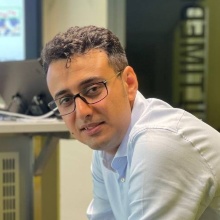Kontakt
+49 711 685 64711
+49 711 685 60430
E-Mail
Pfaffenwaldring 61
70569 Stuttgart
Deutschland
Raum: U1.950
Sprechstunde
Nur nach Vereinbarung
High School Diploma
2010 in KhorramAbad (Iran)
Akademische Grade
2014: B.Sc. in Chemical and Petroleum Engineering - Reservoir Engineering, Petroleum University of Technology, Ahwaz (Iran)
2017: M.Sc. in Chemical and Petroleum Engineering - Reservoir Engineering, Sharif University of Technoloy, Tehran (Iran)
2023: Promotion (Dr.-Ing.), Universität Stuttgart
Akademischer Werdegang
2019-2023: wissenschaftlicher Mitarbeiter (Doktorand) im Internationalen Graduiertenkolleg "DROPIT", Institut für Wasser- und Umweltsystemmodellierung, Universität Stuttgart
seit 9/2023: akademischer Mitarbeiter (Postdoktorand), SFB 1313 "Interface-Driven Multi-Field Processes in Porous Media – Flow, Transport and Deformation", Universität Stuttgart
- 2010-2014: Stipendium der "Petroleum University of Technology"
- 2016: Forschungsstipendium vom "Iran Nanotechnology Innovation Council" für die Anwendung von Nanopartikeln bei der verbesserten Ölgewinnung
- 2018: Auszeichnung als "Distinguished University Graduate" von der "Iran's National Elites Foundation"
Publikationen
Promotionen
- Veyskarami, M. (2023). Coupled free-flow-porous media flow processes including drop formation (Vol. 303) [Promotionsschrift, Eigenverlag des Instituts für Wasser- und Umweltsystemmodellierung der Universität Stuttgart]. http://dx.doi.org/10.18419/opus-13894
(Zeitschriften-) Aufsätze
- Veyskarami, M., Bringedal, C., & Helmig, R. (2024). Modeling and Analysis of Droplet Evaporation at the Interface of a Coupled Free-Flow--Porous Medium System. Transport in Porous Media. https://doi.org/10.1007/s11242-024-02123-7
- Veyskarami, M., Michalkowski, C., Bringedal, C., & Helmig, R. (2023). Droplet Formation, Growth and Detachment at the Interface of a Coupled Free-FLow--Porous Medium System: A New Model Development and Comparison. Transport in Porous Media, 149, 389–419. https://doi.org/10.1007/s11242-023-01944-2
- Wu, H., Veyskarami, M., Schneider, M., & Helmig, R. (2023). A New Fully Implicit Two-Phase Pore-Network Model by Utilizing Regularization Strategies. Transport in Porous Media. https://doi.org/10.1007/s11242-023-02031-2
- Ackermann, S., Fest-Santini, S., Veyskarami, M., Helmig, R., & Santini, M. (2023). Experimental validation of a coupling concept for drop formation and growth onto porous materials by high-resolution X-ray imaging technique. International Journal of Multiphase Flow, 160. https://doi.org/10.1016/j.ijmultiphaseflow.2022.104371
- Michalkowski, C., Veyskarami, M., Bringedal, C., Helmig, R., & Schleper, V. (2022). Two-phase Flow Dynamics at the Interface Between GDL and Gas Distributor Channel Using a Pore-Network Model. Transport in Porous Media, 144, Article 2. https://doi.org/10.1007/s11242-022-01813-4
- Veyskarami, M., Hassani, A. H., & Ghazanfari, M. H. (2019). Monitoring the behaviour of anionic polymer-anionic surfactant stabilized foam in the absence and presence of oil:Bulk and bubble-scale experimental analyses. The Canadian Journal of Chemical Engineering, 97. https://doi.org/10.1002/cjce.23368
- Veyskarami, M., & Ghazanfari, M. H. (2018). Synergistic effect of like and opposite charged nanoparticle and surfactant on foam stability and mobility in the absence and presence of hydrocarbon:A comparative study. Journal of Petroleum Science and Engineering, 166. https://doi.org/10.1016/j.petrol.2018.03.076
- Veyskarami, M., Hassani, A. H., & Ghazanfari, M. H. (2018). A new insight into onset of inertial flow in porous media using network modeling with converging/diverging pores. Computational Geosciences, 22. https://link.springer.com/article/10.1007/s10596-017-9695-3
- Hassani, A. H., Veyskarami, M., Al-Ajmi, A. M., & Masihi, M. (2017). A modified method for predicting the stresses around producing boreholes in an isotropic in-situ stress field. International Journal of Rock Mechanics and Mining Sciences, 96. https://doi.org/10.1016/j.ijrmms.2017.02.011
- Veyskarami, M., Hassani, A. H., & Ghazanfari, M. H. (2016). Modeling of non-Darcy flow through anisotropic porous media:Role of pore space profiles. Chemical Engineering Science, 151. https://doi.org/10.1016/j.ces.2016.05.020
Aktuelle Forschungsprojekte
-
SFB 1313, A02: Modellkonzepte für gekoppelte freie Strömungen mit Strömungen in porösen Medien
Laufzeit: 01/2018 - 12/2025
Abteilungen: LH2 und ITLR
Leitung: Rainer Helmig, Bernhard Weigand, Martin Schneider
Finanzierung: DFG -
GRK 2160 DROPIT: Upscaling of coupled free-flow and porous-media-flow processes
Laufzeit: 10/2016 - 09/2025
Abteilung: LH2
Leitung: Rainer Helmig, Carina Bringedal
Finanzierung: DFG


